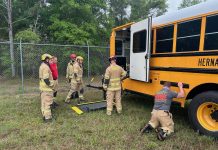NASDPTS and the School Bus Manufacturers Technical Council (SBMTC) released a position paper following further industry discussions regarding misguided state bills that may be filed in response to school-bus fires.
Instead, the legislation has fanned flames of confusion, as was the case recently in Maryland. The final law resulted in a clearer definition of fire block test standards for school buses that are in alignment with those recommended by the National School Bus Specifications & Procedures, as passed by the National Congress on School Transportation (NCST).
But, as state director Leon Langley explained at the recent NASDPTS annual conference in Cincinnati, the original bill was clouded in curious language that would have required school bus seats purchased in Maryland to adhere to American Society for Testing and Materials (ASTM) International Standard E1537 for upholstered furniture.
Meanwhile, the industry-at-large complies with the criteria of the school bus seat upholstery fire block test. The introduced legislation also called for each plastic component contained in the school bus engine compartment to meet a V-0 classification when tested in accordance with Standards for Safety UL 94.
The provisions were supported by the California non-profit group Citizens for Fire Safety, but Langley pointed out that NHTSA governs Federal Motor Vehicle Safety Standards for school buses and could address the issue at the federal level. He added every state has language in their specs that address fire safety.
While the language was ultimately removed before the bill passed, Langley told his fellow state directors that the exercise proved the importance of collaboration between school districts and manufacturers to make sure any legislation that is introduced makes sense.
Diana Hollander, state director for Nevada, told the group that a similar legislative attempt was made in her state. Bruce Miles, chair of the SBMTC, also presented an overview of the then-draft guidelines for NASDPTS members to utilize when working with their respective lawmakers. NASDPTS later approved the paper, which was released today.
SBMTC found that ASTM E1537, for example, is only applicable to jails, prisons, nursing care homes, health care facilities, public auditoriums, hotels, and motels and does not list applicability to any vehicles or modes of transportation. In comparision, NCST’s School Bus Seat Upholstery Fire Block Test uses a weighed amount of newspaper placed in one of three positions — either on top of the seat cushion, behind the seat, or in the aisle adjacent to the seat — and the test is conducted inside a simple test chamber that is a representative section of a bus body.

Regarding the testing of plastic components, SBMTC advised that UL94 V-0 was designed to test the flammability of materials used for parts in devices and appliances, not vehicles. Additionally, SBMTC said that Brominated Flame Retardant (BFR) chemicals are typically used to meet UL94 V-0 classification, and it remains unknown what effect these BFR chemicals could have on plastic components in the engine compartment environment.
“There are over 100 items that could be interpreted to be a ‘plastic component contained in the engine compartment of a school bus,” the paper said.
Also during the Oct. 22 NASDPTS panel discussion in Cincinnati, Dan Schultz, transportation director for Southeast Polk Community School District in Pleasant Iowa, discussed a school bus fire and explosion, and the importance of evacuation training for drivers and students. School bus driver John Fothergill safely managed to evacuate the bus after noticing the first signs of an engine fire. He received the Blue Bird Heroism Award for his actions.
















